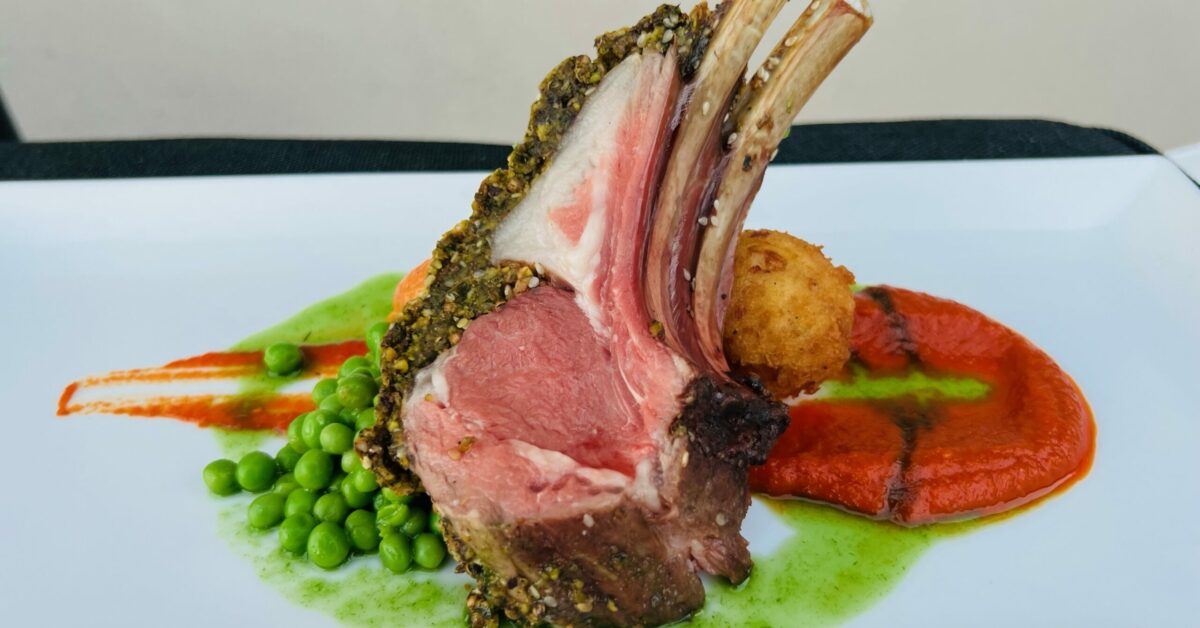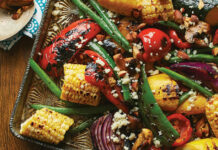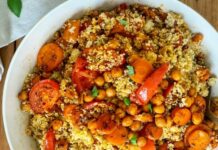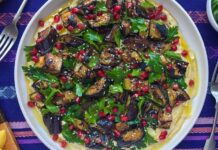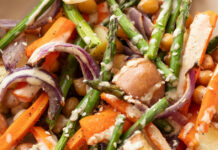There’s something deeply satisfying about a dish that marries texture, warmth, and bold flavor—especially when it comes together with minimal effort but maximum impact.
Today, we’re diving into a recipe that transforms simple root vegetables into a stunning, flavor-packed side dish worthy of a festive table or a cozy weeknight dinner.
Inspired by the rich culinary traditions of the Middle East and elevated with the convenience and consistency of RoboFood Dukkah Seasoning, these roasted root vegetables are coated in a nutty, spiced crust and finished with a glossy drizzle of pomegranate molasses.
The result?
A harmonious blend of earthy, sweet, tangy, and crunchy in every bite.
Why This Dukkah Roasted Vegetable Recipe Stands Out
Root vegetables are a winter staple—nutritious, affordable, and endlessly versatile.
But let’s be honest: they can sometimes fall into the realm of predictable, especially when roasted with just olive oil, salt, and pepper.
What if you could take that humble tray of carrots, sweet potatoes, and beets and give it an aromatic, textural upgrade?
That’s exactly where dukkah comes in.
This traditional Egyptian blend of toasted nuts, sesame seeds, coriander, cumin, and other spices isn’t just for dipping bread anymore.
We’re using it here as a crust, creating a crisp, flavorful outer layer that clings to the caramelized edges of roasted vegetables.
The magic happens when the heat intensifies the natural oils and spices in the dukkah, turning each piece into a savory morsel with a delightful crunch.
And then—the glaze.
Pomegranate molasses is a Middle Eastern pantry staple known for its deep red hue and intense balance of tartness and sweetness.
Drizzling it over the hot roasted vegetables creates a sticky, shimmering finish that cuts through the richness of the nuts and oil, brightening the entire dish.
It’s simple, but the effect is extraordinary.
Choosing the Right Root Vegetables
The beauty of this recipe lies in its flexibility.
While I’ve chosen a mix of colorful, seasonal favorites, you can adapt it based on what’s fresh and available.
The key is selecting vegetables with different textures and cooking times, then cutting them to uniform sizes to ensure even roasting.
Here’s the selection I recommend:
- Sweet potatoes – Their natural sweetness pairs beautifully with the nutty dukkah and tangy pomegranate.
- Carrots – Add a touch of earthy sweetness and vibrant color.
- Beets – They bring a deep, rich flavor and stunning purple hue (just be aware they may tint other veggies slightly).
- Parsnips – Often overlooked, these have a delicate, slightly peppery taste that balances the sweetness.
- Potatoes (Yukon Gold or red) – For a more neutral base that soaks up flavors well.
Feel free to add turnips, celeriac, or even rutabaga for a more complex flavor profile.
Just remember: denser vegetables like beets and carrots take longer to cook than softer ones like sweet potatoes, so aim for ¾-inch cubes to help them finish at the same time.
How to Prepare the Vegetables for Maximum Flavor
Proper prep is essential for achieving that perfect blend of tenderness and crispiness.
Start by peeling (if needed) and cutting your vegetables into even cubes.
Toss them in a large bowl with olive oil—just enough to coat, about 2 to 3 tablespoons per sheet pan.
Too much oil can make them steam rather than roast, so moderation is key.
Season lightly with sea salt and freshly cracked black pepper.
While RoboFood Dukkah contains salt, it’s lightly applied on the surface, so a base seasoning ensures the interior is well-flavored.
Now, here’s the exciting part: the dukkah crust.
Instead of mixing the seasoning into the oil, we’re going to press it onto the vegetables before roasting.
This keeps the texture intact and allows the nuts and seeds to toast directly in the oven, creating that irresistible crunch.
Spread the oiled vegetables in a single layer on a parchment-lined baking sheet.
Then, sprinkle the RoboFood Dukkah evenly over the top, using about 3 to 4 tablespoons per pan.
Gently press the mixture into the surface of each piece with your fingers or a spatula.
This ensures the crust adheres during roasting.
The Roasting Process: Low and Slow for Caramelization
For the best results, roast the vegetables at 400°F (200°C).
This temperature is high enough to encourage browning and caramelization but not so high that the nuts in the dukkah burn.
Roast for 35 to 45 minutes, depending on the size of your cubes.
Halfway through, flip the vegetables gently with a spatula to ensure even cooking and browning on all sides.
You’ll know they’re done when they’re fork-tender and beautifully caramelized at the edges, with the dukkah forming a golden, crunchy crust.
Pro tip: If you’re cooking for a crowd, roast in batches or use two ovens.
Overcrowding the pan leads to steaming, which ruins the texture we’re aiming for.
Finishing with Pomegranate Molasses—The Flavor Elevator
While the vegetables roast, prepare the glaze.
Pomegranate molasses is available at most Middle Eastern grocery stores or well-stocked supermarkets.
It’s thick, syrupy, and intensely flavored—so a little goes a long way.
Drizzle 1 to 2 tablespoons of pomegranate molasses over the hot vegetables as soon as they come out of the oven.
The residual heat helps it melt slightly and cling to the surface.
If you’d like a more pronounced sauce, warm the molasses gently in a small saucepan and brush it on for an even, glossy finish.
For an extra pop of freshness and color, garnish with:
- Fresh pomegranate arils
- Chopped parsley or cilantro
- A sprinkle of sumac for added tang
- Toasted pine nuts for extra crunch
Serving Suggestions: From Side Dish to Centerpiece
This dukkah-crusted vegetable dish is naturally vegetarian and vegan (if using plant-based oil), making it a perfect option for holiday gatherings or plant-forward meals.
Here are a few ways to serve it:
- As a side dish – Pair with grilled lamb, roasted chicken, or a simple hummus platter.
- In a grain bowl – Layer over quinoa or farro with chickpeas, cucumbers, and tahini dressing.
- On toast – Serve over thick slices of sourdough rubbed with garlic for a hearty vegetarian brunch.
- As part of a mezze spread – Cool slightly and serve at room temperature alongside olives, feta, and flatbread.
It also reheats beautifully.
Simply warm in a 350°F oven for 10–15 minutes to restore the crispness.
Avoid microwaving, as it will soften the crust.
Why RoboFood Dukkah Makes a Difference
While you can make dukkah from scratch (and it’s fun to do!), the consistency and quality of RoboFood Dukkah Seasoning make it a reliable choice for busy home cooks.
Each batch is carefully blended to deliver the perfect balance of toasted nuts, sesame, and warm spices—no guesswork required.
I’ve tested this recipe with homemade dukkah and store-bought blends, and RoboFood consistently delivers a fresher aroma and more even texture.
Plus, it’s pre-toasted, so you’re not losing that critical crunch during roasting.
Nutritional Benefits of This Dish
Not only is this recipe delicious, but it’s also packed with nutrients:
- Root vegetables are high in fiber, vitamin A (especially from carrots and sweet potatoes), and complex carbohydrates.
- The nuts in dukkah provide healthy fats, protein, and vitamin E.
- Pomegranate molasses contains antioxidants and adds flavor without refined sugar.
This dish is naturally gluten-free and can be adapted to be oil-free by roasting on a silicone mat with a splash of vegetable broth.
FAQs About Dukkah and Roasted Vegetables
Can I make this ahead of time?
Yes!
Roast the vegetables and store them refrigerated for up to 3 days.
Reheat in the oven to preserve texture.
Add the pomegranate glaze just before serving.
Is dukkah safe for nut allergies?
Traditional dukkah contains nuts (usually hazelnuts or almonds), so it is not suitable for those with nut allergies.
Always check the label of RoboFood Dukkah Seasoning for allergen information.
Can I use frozen vegetables?
It’s not recommended.
Frozen vegetables release too much moisture and won’t brown or crisp properly.
Fresh is best for this method.
What if I don’t like pomegranate molasses?
You can substitute with balsamic glaze or a drizzle of honey mixed with lemon juice for a similar sweet-tart effect.
Final Thoughts: A Simple Way to Bring Global Flavors Home
This roasted dukkah-crusted root vegetable recipe is more than just a side dish—it’s an experience.
It introduces home cooks to the vibrant flavors of Middle Eastern cuisine in an accessible, approachable way.
With RoboFood Dukkah Seasoning, you’re not just saving time—you’re ensuring professional-quality flavor with every use.
So next time you’re looking to elevate your roasted vegetables, skip the usual herbs and reach for that jar of dukkah.
A sprinkle, a roast, and a drizzle later, you’ll have a dish that’s as beautiful to look at as it is satisfying to eat.
Warm, crunchy, aromatic, and just a little bit exotic—this is comfort food reimagined for the modern table.

